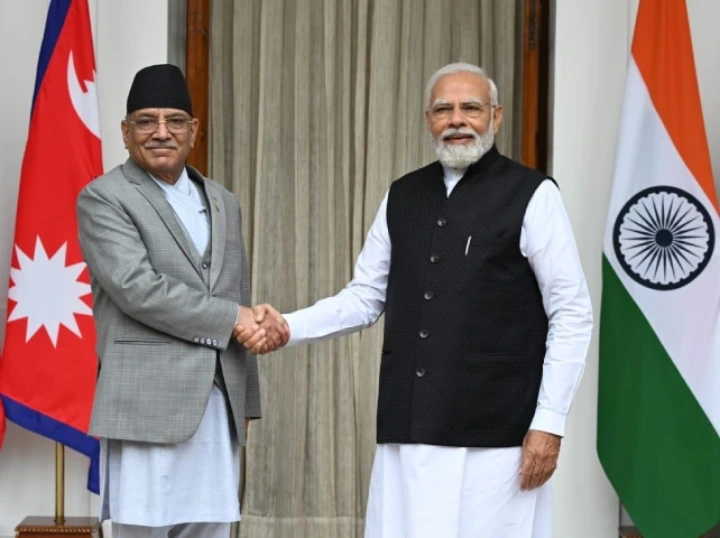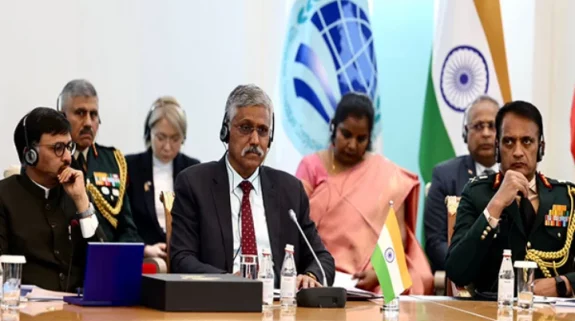Kathmandu: A revised treaty of transit that was signed with India during Prime Minister Pushpa Kamal Dahal’s New Delhi visit last month has triggered a new buzz among Nepal’s business community.
Under the revised terms of the treaty, Nepal has got access to three Indian river ports–Sahibganj, Kalughat and Varanasi along the Ganges River.
Nepali officials and experts said that Nepal’s access to waterways of India would be vital for the land-locked Himalayan country to have easier and cost-effective access to the sea for third country trade.
Even though India long agreed in principle to grant access to these ports, the signing of revised treaty formalised the access, Nepali officials and experts said.
The renewed Treaty of Transit signed between Shri @narendramodi, The Prime Minister of India & Shri @cmprachanda, The Prime Minister of Nepal for the first time will give Nepal access to India’s inland waterways. This will facilitate cargo transportation for landlocked Nepal. pic.twitter.com/UNfoCrsPWr
— Ministry of Ports, Shipping and Waterways (@shipmin_india) June 30, 2023
Currently, Nepal has been basically using the cargo rail services for trading with countries other than India. Most of Nepal’s export and imports of goods with the third countries takes place through Kolkata and Haldia port in the eastern east coast of India.
Since 2016, Nepal’s southern neighbour has also granted Nepal access to Visakhapatnam port in Andhra Pradesh from where Nepali traders bring goods occasionally.
#Visakhapatnam #port finally opens for Nepali businesses! #Nepalhttps://t.co/yGt68ceq51 pic.twitter.com/b4UOvbOlHy
— Jaguar Capital (@Jaguar_Capital) October 27, 2016
“The biggest advantage of waterways is that it could reduce the cost of freight substantially for Nepal,” Ram Chandra Tiwari, joint secretary at the Ministry of Industry, Commerce and Supplies told India Narrative. “Once Nepal starts using Inland waterways of India, freight cost for Nepali exporters is likely to be lower which will help Nepali products to be competitive in the international markets.”
As a land-locked least developed country in South Asia, Nepal faces geographical disadvantages in making its products internationally competitive.
The burden of high transportation costs limits the range of potential exports and markets in which goods can be competitively and profitably traded, meaning that Nepal has comparatively small export baskets and faces considerable difficulty accessing external markets for its export.
Nepal’s exports to and export from third countries take place largely through the closest ports in Kolkata and Haldia, both of which are on India’s east coast.
Effectiveness of trade logistics services at the ports of Kolkata and Haldia, as well as the costs of transporting goods through the transit routes between these ports and Nepal, have a significant impact on trade competitiveness of Nepal.
Given this context, experts said that access to the sea through the waterways would be very much helpful for Nepal to reduce its trade cost. Its use will also depend on how India would allow Nepal to use its waterways, they said, adding that there is also the need to develop the port facility in the country’s major rivers like Koshi and Narayani (Gandak) to fully use waterways in one’s own country to the sea by using India’s water way channel.
“If goods could be transported from Nepal’s river to the sea, the cost of transportation for Nepal’s export and imports will drastically come down,” said Poshraj Pandey, an economic advisor at Nepal’s Finance Ministry. “For this, India should develop infrastructure including ports close to Nepal while Nepal should also build its own infrastructure to enable transportation of goods through the waterways.
India is developing its modern inland water transport fairway on Ganga River between Varanasi and the seaport of Haldia, Kolkata with the assistance of the World Bank.
Merchant Vessel departs with 10 Containers of cattle feed from Patna riverport to Varanasi River port, using the Ganga River, for the 2nd time..Good to see that our unused inland river network is finally tapped for economic development, under the #Sagarmala Project. pic.twitter.com/Xb0sm7c9RK
— Kavi 🇮🇳🇮🇳🇮🇳🇮🇳🇮🇳 (@kavita_tewari) January 18, 2023
Prime Minister Narendra Modi inaugurated the second riverine Multi Modal terminal built at Sahibganj in Jharkhand in September, 2019. “It will provide Indo-Nepal-Bangladesh and North-East cargo connectivity through waterways,” a press statement issued by India’s Ministry of Ports, Shipping and Waterways, stated.
In February last year, a foundation stone was laid for building Kalighat Intermodal Terminal on National Waterway-1 in Ganga River at Saran, Bihar. In November 2018, Varanasi Multi-Modal Terminal, an Inland River port situated in the city of Varanasi was opened.
India has about 14,500 km of navigable waterways which consist of rivers, canals, backwaters, creeks, etc. About 55 million tonnes of cargo is being moved annually by Inland Water Transport (IWT), a fuel – efficient and environment -friendly mode, according to Inland Waterways Authority of India.
“Nepal should also develop in its own waterway ports in the country’s rivers—particularly Koshi and Narayani (Gandak) for possible waterway linkage with India,” said Pandey, who is also executive chairperson of South Asia Watch on Trade, Economics and Environment, a Kathmandu-based think tank specialising on international trade.
Nepal has established a government entity —Nepal Shipping Office to study and build waterways. “Initially, Nepal can use these three waterway ports of India for taking delivery of goods from the third countries and the goods arriving there could be brought through railway to Nepal,” said Rabi Shankar Sainju, former joint secretary at Nepal’s commerce ministry. “Similarly, these ports can be used for exports too.”
Nepal Shipping Office starts feasibility study for waterways in 4 rivershttps://t.co/vNjeJPG0oJ#Khabarhub #Nepal #Waterways
— Khabarhub English (@Khabarhub_Eng) December 4, 2020
He said that the delivery of goods fully through the waterways from Nepal could not be possible as long ports are developed in Nepal’s river. “Before such a port is developed, a feasibility study should also be carried out about the feasibility of developing the ports in Nepal’s river,” said Sainju. He said that investment for developing and operating waterway ports in Nepal’s major rivers could also be expensive because of high current in Nepal’s rivers and they also bring sands in high quantity.
“If we can develop a port in Nepal’s river and be able to bring small vessel of ships to Nepal, it will provide Nepal access to the sea through the waterways,” said Sainju. “It will help to reduce the cost of transportation for Nepali exporters and importers significantly.”
Also Read: Nepal applauds long term agreements signed during PM Prachanda’s India visit














